Volleyball drills for technique passing / defense / reception
- 2 rows of players
- 1 row on the left back
- 1 row at the right back
- create with 4 pawns a virtual line where they have to stand behind
- trainer stands at the other side of the net and throws the ball somewhere in the field.
- 1 of the 2 front rows calls LOS orIK (agree on that)
- this player passes the ball over the net to the other (who did not call loose)
- player who has caught the ball puts it in the bin.
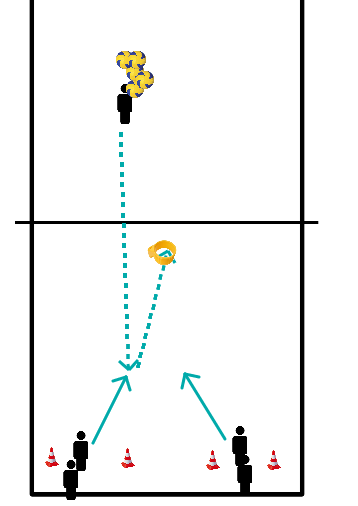
- A serves to B.
- B passes the ball to the playmaker, who then plays a high ball into the backfield.
- B defends this ball back to the playmaker, who then gives a setup for A.
- A attacks on this setup.
After the attack, A takes B's place and B becomes a reserve. The playmaker stays.
The outfield attackers use the left half of the court with one playmaker. The middle attackers and diagonal attackers use the right half with another playmaker.
Extension:
- After the service, A takes a second ball.
- After B's attack A throws this ball into the field.
- B plays this ball to the playmaker, the playmaker gives a setup.
- B attacks again.
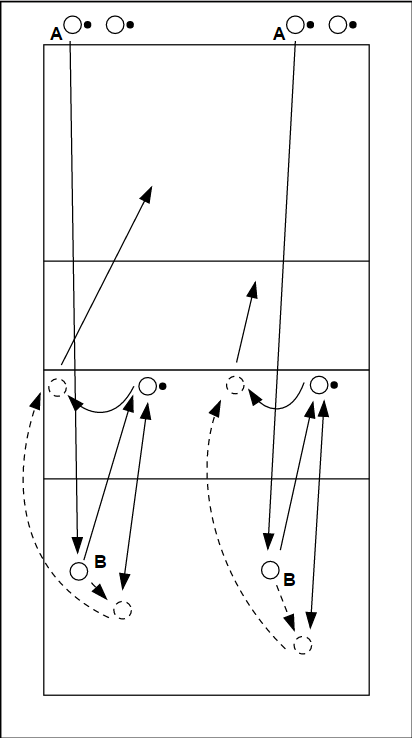
Blocking:
Defense:
Moving as long as you can is in my case the moment the attacker barely touches the ball. At that moment, you make a split step as a defender and make sure that your body's centre of gravity (LZP) has been brought forward. So do not move backwards when the ball is hit because your LZP is then behind you and you are too late to defend the ball in front of you. If the ball is defended, then rally. 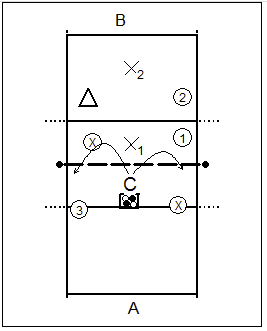 |
- Player A throws ball over the net.
- Player B or C passes ball to other player
- The other player quickly runs to the net and sets up the ball for the same player who passed.
- This player tries to get a pawn off the bench with overhand play or a hitting move.
- Change after 5 balls
Which pair or team has knocked off/handled the most pawns after X number of minutes?
- 2 rows of players
- 1 row on the left back
- 1 row at the right back
- create with 4 pawns a virtual line where they have to stand behind
- trainer stands at the other side of the net and throws the ball somewhere in the field.
- 1 of the 2 front rows calls LOS orI (agree on this)
- This player passes the ball into the basket on the players spot.
- At the basket stands a catcher who brings the ball to the trainer in the basket.
- The player who passes runs after the ball.
- Catch a round for the next one
- If you did not have the ball, join the shortest row.

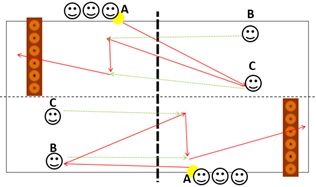
- Player A throws ball over the net.
- Player B or C passes the ball over the net.
- The other player quickly runs under the net and sets up the ball for the same player who passed.
- This player tries to get a pawn off the bench with overhand play or a hitting move.
Which pair or team has knocked the most pawns off the bench after X number of minutes?
- trainer stands at the other side of the net and throws the ball somewhere in the field
- player passes ball into basket
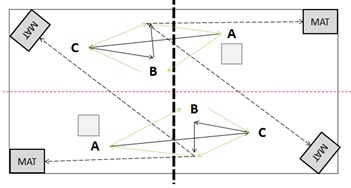
- Player A throws/strikes the ball towards player C.
- Player C passes the ball to player B.
- Player B sets up the ball.
- Player C attacks.
Goal: try to attack/play 3rd ball on the mats (straight or diagonal).
After each ball move one place in your own group.
Extension: When there are enough players one could also choose to place a block.
- 2 rows of players
- 1 row on the left back
- 1 row at the right back
- create with 4 pawns a virtual line where they have to stand behind
- trainer stands at the other side of the net and throws the ball somewhere in the field.
- 1 of the 2 front rows calls LOS orIK (agree on that)
- This player passes the ball over the net to the previous player.
- catch a round for the next player
- If you did not have the ball, join the shortest row.

3 players at the net at equal distance from each other (1, 2, 3, 4).
3 players on the backline (A, B, C, D).
- Player A plays BH to player 1,
- player 1 plays BH back,
- player A plays BH to player 2,
- player 2 plays BH back,
- etc.
The moment player A plays to player 2, player B starts playing BH to player 1, etc.
One scapegoat is appointed, this scapegoat must try to catch the other players within the yellow lines.
- Has the ticker ticked 3 players? Next ticker!
- The whole volleyball field is the playing field.
- In the middle of the field the net hangs about 40 cm above the ground (do not tighten the bottom line for safety reasons).
- The players and tickers can dive under the net to get to the other side of the court.
- 2 rows of players
- 1 row on the left back
- 1 row at the right back
- create with 4 pawns a virtual line where they have to stand behind
- trainer stands at the other side of the net and throws the ball somewhere in the field.
- 1 of the 2 front rows calls LOS orI (agree on that)
- this player passes the ball to the playmaker, setup and attack straight ahead. Attacker retrieves his own ball.
- The playmaker goes on the attack, Paschal becomes setupper, the attacker joins the shortest row.
- If you did not have the ball, join the shortest line.








